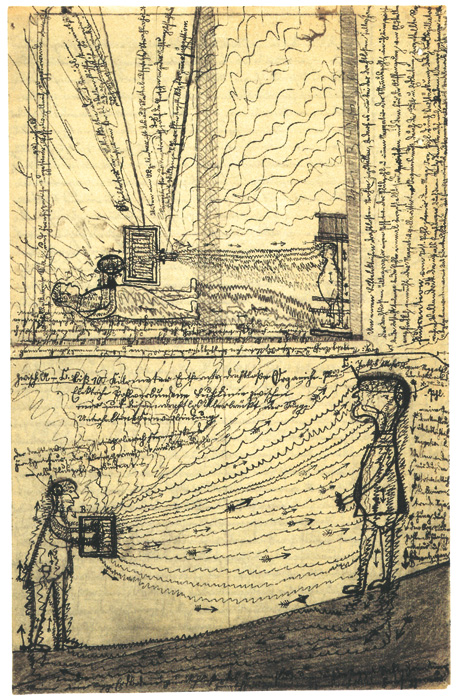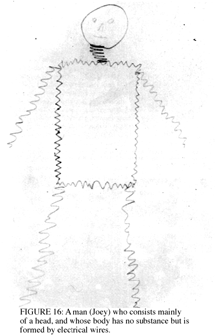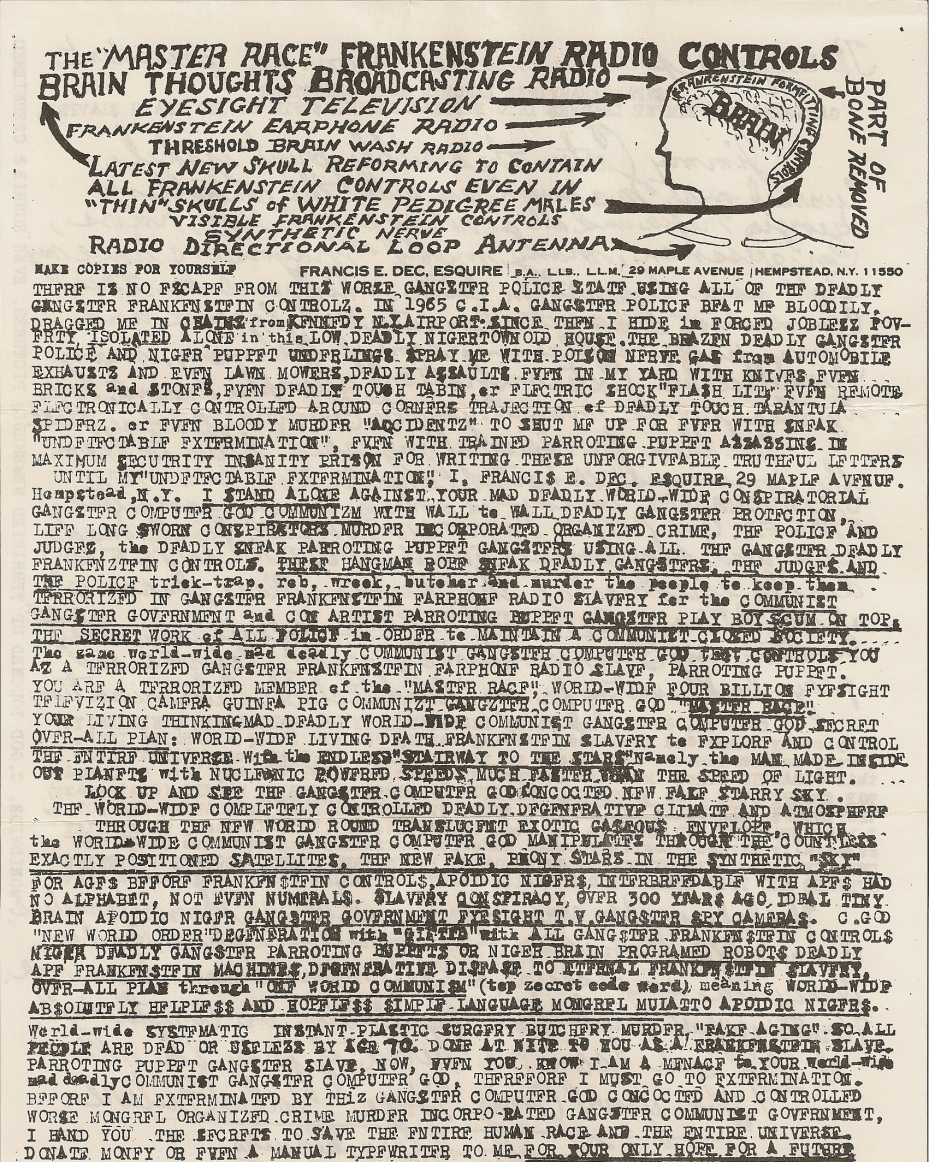User:Amy Suo Wu/notes, research and digressions: Difference between revisions
Amy Suo Wu (talk | contribs) |
Amy Suo Wu (talk | contribs) No edit summary |
||
| Line 1: | Line 1: | ||
== hybrid realities == | == hybrid realities == | ||
| Line 51: | Line 50: | ||
* Jakob Mohr | * Jakob Mohr | ||
"The psychiatrist Hans Prinzhorn began collecting for his famous Museum of Pathological Art the same year that Tausk published his essay (within a year Prinzhorn had acquired 4,500 works, which are currently housed in the Psychiatric University Hospital in Heidelberg, Germany). One of these images illustrates an Influencing Machine in strikingly graphic form. The artist was Jakob Mohr, a farmer and hawker suffering from paranoid schizophrenia, and his picture shows someone holding a small box which resembles an old-fashioned camera and transmits something like static at its victim. The structural workings of the contraption are explained in a palimpsest of scribbled notes, which Prinzhorn called “word salad.” The operator, who is thought to be the psychiatrist (he wears headphones so that he can listen in on Mohr’s thoughts), aims a radiation tube at his subject that emits “electric waves” and renders him a “hypnotic slave.” The machine’s energy flows two ways—it is a magnet as well as a gun: “Waves are pulled out of me,” Mohr scrawled, “through the positive electrical fluorescent attraction of the organic positive pole as the remote hypnotizer through the earth.” The appliance’s malevolent power over Mohr is illustrated by a series of childishly drawn arrows and wavy tentacles which unite both men in a painful-looking spasm of electricity." Quoted from [http://www.cabinetmagazine.org/issues/14/turner.php this] article. | "The psychiatrist Hans Prinzhorn began collecting for his famous Museum of Pathological Art the same year that Tausk published his essay (within a year Prinzhorn had acquired 4,500 works, which are currently housed in the Psychiatric University Hospital in Heidelberg, Germany). One of these images illustrates an Influencing Machine in strikingly graphic form. The artist was Jakob Mohr, a farmer and hawker suffering from paranoid schizophrenia, and his picture shows someone holding a small box which resembles an old-fashioned camera and transmits something like static at its victim. The structural workings of the contraption are explained in a palimpsest of scribbled notes, which Prinzhorn called “word salad.” The operator, who is thought to be the psychiatrist (he wears headphones so that he can listen in on Mohr’s thoughts), aims a radiation tube at his subject that emits “electric waves” and renders him a “hypnotic slave.” The machine’s energy flows two ways—it is a magnet as well as a gun: “Waves are pulled out of me,” Mohr scrawled, “through the positive electrical fluorescent attraction of the organic positive pole as the remote hypnotizer through the earth.” The appliance’s malevolent power over Mohr is illustrated by a series of childishly drawn arrows and wavy tentacles which unite both men in a painful-looking spasm of electricity." Quoted from [http://www.cabinetmagazine.org/issues/14/turner.php this] article. | ||
[[File:Strang16.GIF]] | [[File:Strang16.GIF]] | ||
| Line 56: | Line 56: | ||
* Joey the Mechanical Boy | * Joey the Mechanical Boy | ||
"Dubos’s comment is interesting, because it links a schizophrenic attitude to the “dehumanized” and “mechanized.” Since the psychiatrist Victor Tausk’s classic paper on the “influencing machine” in schizophrenia, it had been well known that some schizophrenic patients felt as if they were influenced by a mechanical environment (thus the name “influencing machine”), and further that part of their body was projected onto the environment, resulting in the loss of “ego boundary” between the human self and the mechanical environment (Tausk 1991). The March 1959 issue of Scientific American reported a surprising story about Joey, a “Mechanical Boy,” who thought of himself as a machine or robot while suffering from severe schizophrenia. Joey behaved as if he was a machine, being controlled by a remote control of his own fantasy. The imaginary machines that surrounded him had emotions and will power. He connected himself to various tubes and motors, but sometimes destroyed them with fury and then immediately connected himself up to bigger tubes and machines. Dr. Bruno Bettelheim who treated Joey discovered that his parents had transformed him into a type of machine by treating him “mechanically” without love or tenderness. Joey wanted these machines to dominate his mind and body because it had become too painful for him to be a human. The doctor therefore tried to revive the sense of human trust and feelings inside him. As Joey made progress, he gradually regained control of the mechanical environments around him. Then, he became able to relate emotionally to people. Bettelheim remarked that “robots cannot live and remain sane,” because they will become “golems” and “destroy their world and themselves.” Before this happened to Joey, humanity went back into the saddle and saved him (Bettelheim 1959)." Quoted from [http://webcache.googleusercontent.com/search?q=cache:gF2fHyXROkIJ:scrc.postech.ac.kr/seminar/man%2520and%2520machine%2520in%2520the%25201960s.rtf+Dubos%E2%80%99s+comment+is+interesting,+because+it+links+a+schizophrenic+attitude+t+o+the+%E2%80%9Cdehumanized%E2%80%9D+and+%E2%80%9Cmechanized.%E2%80%9D&cd=2&hl=nl&ct=clnk&gl=nl&client=firefox-a&source=www.google.nl this] article. | "Dubos’s comment is interesting, because it links a schizophrenic attitude to the “dehumanized” and “mechanized.” Since the psychiatrist Victor Tausk’s classic paper on the “influencing machine” in schizophrenia, it had been well known that some schizophrenic patients felt as if they were influenced by a mechanical environment (thus the name “influencing machine”), and further that part of their body was projected onto the environment, resulting in the loss of “ego boundary” between the human self and the mechanical environment (Tausk 1991). The March 1959 issue of Scientific American reported a surprising story about Joey, a “Mechanical Boy,” who thought of himself as a machine or robot while suffering from severe schizophrenia. Joey behaved as if he was a machine, being controlled by a remote control of his own fantasy. The imaginary machines that surrounded him had emotions and will power. He connected himself to various tubes and motors, but sometimes destroyed them with fury and then immediately connected himself up to bigger tubes and machines. Dr. Bruno Bettelheim who treated Joey discovered that his parents had transformed him into a type of machine by treating him “mechanically” without love or tenderness. Joey wanted these machines to dominate his mind and body because it had become too painful for him to be a human. The doctor therefore tried to revive the sense of human trust and feelings inside him. As Joey made progress, he gradually regained control of the mechanical environments around him. Then, he became able to relate emotionally to people. Bettelheim remarked that “robots cannot live and remain sane,” because they will become “golems” and “destroy their world and themselves.” Before this happened to Joey, humanity went back into the saddle and saved him (Bettelheim 1959)." Quoted from [http://webcache.googleusercontent.com/search?q=cache:gF2fHyXROkIJ:scrc.postech.ac.kr/seminar/man%2520and%2520machine%2520in%2520the%25201960s.rtf+Dubos%E2%80%99s+comment+is+interesting,+because+it+links+a+schizophrenic+attitude+t+o+the+%E2%80%9Cdehumanized%E2%80%9D+and+%E2%80%9Cmechanized.%E2%80%9D&cd=2&hl=nl&ct=clnk&gl=nl&client=firefox-a&source=www.google.nl this] article. | ||
| Line 63: | Line 64: | ||
Francis E. Dec (January 6, 1926 – January 21, 1996) was a U.S. lawyer from Hempstead Village, New York, disbarred for fraud in 1959, and later known for the bizarre socio-political tracts of conspiracy theories he mass-mailed to the media. Often denouncing a "Worldwide Mad Deadly Communist Gangster Computer God"[1] mind-controlling mankind, Dec is considered to have been a paranoid schizophrenic of the influencing-machine delusion kind, and is often referred to as a "kook". Quoted from [http://en.wikipedia.org/wiki/Francis_E._Dec#cite_ref-Dec-MRFRC_0-0 this] wiki article | Francis E. Dec (January 6, 1926 – January 21, 1996) was a U.S. lawyer from Hempstead Village, New York, disbarred for fraud in 1959, and later known for the bizarre socio-political tracts of conspiracy theories he mass-mailed to the media. Often denouncing a "Worldwide Mad Deadly Communist Gangster Computer God"[1] mind-controlling mankind, Dec is considered to have been a paranoid schizophrenic of the influencing-machine delusion kind, and is often referred to as a "kook". Quoted from [http://en.wikipedia.org/wiki/Francis_E._Dec#cite_ref-Dec-MRFRC_0-0 this] wiki article | ||
== more info / sources == | == more info / sources == | ||
Revision as of 14:26, 6 May 2011
hybrid realities
In the third memory (1999), by Pierre Huyghe, the interplay between fiction and reality are blurred and have become hybridized. John Wotjtowicz watches the movie The Godfather staring Al Pacino. Inspired, he commits a bank robbery in 1972 only to have, Al Pacino star in another movie, Dog Day Afternoon (1975) based on the real story of John and the surrounding event that had been inspired by The Godfather. Beyond the beginning of this loop, what inspired the making of the Godfather? Was it a real or an imagined event or chain of events? It is realities' flimsy and shape-shifting properties that are for me a source of infinite fascination. For me, reality and fiction are interchangeable, fluid and continuous like the Ouroboros who eats his own tail. Here , Dutch film maker tries to make a documentary about 'a truth being so strange that it becomes a super fiction'
Which bring me to think of "imagined" realities, dreams, daydreams and of hallucinations. Are these imaginary images a reflection of real events or do they come in from your subconscious, in the sense that hallucinations are perceived realities created in the negation of external stimulus. Made me think of events like landing of the moon and more recently the killing of Osama Bin Laden in which the authenticity of so-called "verifying" documents are challengable and suspicious. How do figments of peoples imagination enter into the realm of collective psyche and then reality until it enters into the stage of memory?
Artist Zoe Beloff is interested in mad women and mediums from last century. The work called 'Shadow Land or Light From the Other Side', is a based on the autobiography written in 1897 by a medium who was know to conjure up full body apparitions. In this work, she reanimates these spirits and shadows in 3D. The illusions are projected in the space and similar to 100 years ago, while the audience knew it was probably a clever trick, they believed it anyway. Interest in the paranormal and spiritualism that was highly popular during that time and had existed and circulated in the collective memory of even scientific men. She literally reanimates the images from the popular psyche of the public. The idea of re-enacting a collected hybrid reality or an imagined reality would be interesting.
questions, possibilities
- where do the memories of these images come from?
- realities are re-mediated as a result of fluctuations and movements between fiction and/to reality and imagination and/to memory.
- re-enacting/reconstructing images original sources that are of ambiguous nature and yet circulating in the collective memory.
example dream, daydream, hallucination, imagined realities. or of fake events (landing of the moon), myths, legends. illusions.
- resurrection? --> The War of the Worlds was re-enacted in 1938 by Orson Welles as a radio play. It supposedly caused panic and terror among the listeners due to the authenticity of the broadcasting.
- is consensual hallucination virtuality?
Influencing Machine: paranoid delusions, schizophrenia and alternate realities
On the Origin of the "Influencing Machine" in Schizophrenia is a highly influential article written by psychoanalyst Viktor Tausk. It was first published in the journal Psychoanalytic Quarterly in 1933. Rod Dickinson's work 'The Air loom' (2002) and Zoe Beloff's video installation 'The Influencing Machine of Miss Natalija A'(2001) were both inspired by the cases of people experiencing medical conditions of the now familiar belief of imagined mind control by an invented 'influencing machine'.
The paper describes Tausk's observations and psychoanalytic interpretation of a type of paranoid delusion that occurs in patients diagnosed with schizophrenia. The delusion often involves their being influenced by a 'diabolical machine', just outside the technical understanding of the victim, that influences them from afar. It was typically believed to be operated by a group of people who were persecuting the individual, whom Tausk suggested were "to the best of my knowledge, almost exclusively of the male sex" and are "predominantly physicians by whom the patient has been treated". - from wikipedia article
- extract from article (also from wikipedia)
The schizophrenic influencing machine is a machine of mystical nature. The patients are able to give only vague hints of its construction. It consists of boxes, cranks, levers, wheels, buttons, wires, batteries, and the like. Patients endeavor to discover the construction of the apparatus by means of their technical knowledge, and it appears that with the progressive popularization of the sciences, all the forces known to technology are utilized to explain the functioning of the apparatus. All the discoveries of mankind, however, are regarded as inadequate to explain the marvelous powers of this machine, by which the patients feel themselves persecuted. The main effects of the influencing machine are the following:
- 1. It makes the patient see pictures. When this is the case, the machine is generally a magic lantern or cinematograph. The pictures are seen on a single plane, on walls or windowpanes, and unlike typical visual hallucinations are not three dimensional.
- 2. It produces, as well as removes, thoughts and feelings by means of waves or rays or mysterious forces which the patient's knowledge of physics is inadequate to explain. In such cases, the machine is often called a 'suggestion-apparatus.' Its construction cannot be explained, but its function consists in the transmission or 'draining off' of thoughts and feelings by one or several persecutors.
- 3. It produces motor phenomena in the body, erections and seminal emissions, that are intended to deprive the patient of his male potency and weaken him. This is accomplished either by means of suggestion or by air-currents, electricity, magnetism, or X-rays.
- 4. It creates sensations that in part cannot be described, because they are strange to the patient himself, and that in part are sensed as electrical, magnetic, or due to air-currents.
- 5. It is also responsible for other occurrences in the patient's body, such as cutaneous eruptions, abscesses, or other pathological processes.
- The Air Loom, A Human Influencing Machine, 2002, Rod Dickinson
- Article about Miss Natalija A
- more info about video installation Miss Natalija A
- online version of Miss Natalija A
curious case studies
- Jakob Mohr
"The psychiatrist Hans Prinzhorn began collecting for his famous Museum of Pathological Art the same year that Tausk published his essay (within a year Prinzhorn had acquired 4,500 works, which are currently housed in the Psychiatric University Hospital in Heidelberg, Germany). One of these images illustrates an Influencing Machine in strikingly graphic form. The artist was Jakob Mohr, a farmer and hawker suffering from paranoid schizophrenia, and his picture shows someone holding a small box which resembles an old-fashioned camera and transmits something like static at its victim. The structural workings of the contraption are explained in a palimpsest of scribbled notes, which Prinzhorn called “word salad.” The operator, who is thought to be the psychiatrist (he wears headphones so that he can listen in on Mohr’s thoughts), aims a radiation tube at his subject that emits “electric waves” and renders him a “hypnotic slave.” The machine’s energy flows two ways—it is a magnet as well as a gun: “Waves are pulled out of me,” Mohr scrawled, “through the positive electrical fluorescent attraction of the organic positive pole as the remote hypnotizer through the earth.” The appliance’s malevolent power over Mohr is illustrated by a series of childishly drawn arrows and wavy tentacles which unite both men in a painful-looking spasm of electricity." Quoted from this article.
- Joey the Mechanical Boy
"Dubos’s comment is interesting, because it links a schizophrenic attitude to the “dehumanized” and “mechanized.” Since the psychiatrist Victor Tausk’s classic paper on the “influencing machine” in schizophrenia, it had been well known that some schizophrenic patients felt as if they were influenced by a mechanical environment (thus the name “influencing machine”), and further that part of their body was projected onto the environment, resulting in the loss of “ego boundary” between the human self and the mechanical environment (Tausk 1991). The March 1959 issue of Scientific American reported a surprising story about Joey, a “Mechanical Boy,” who thought of himself as a machine or robot while suffering from severe schizophrenia. Joey behaved as if he was a machine, being controlled by a remote control of his own fantasy. The imaginary machines that surrounded him had emotions and will power. He connected himself to various tubes and motors, but sometimes destroyed them with fury and then immediately connected himself up to bigger tubes and machines. Dr. Bruno Bettelheim who treated Joey discovered that his parents had transformed him into a type of machine by treating him “mechanically” without love or tenderness. Joey wanted these machines to dominate his mind and body because it had become too painful for him to be a human. The doctor therefore tried to revive the sense of human trust and feelings inside him. As Joey made progress, he gradually regained control of the mechanical environments around him. Then, he became able to relate emotionally to people. Bettelheim remarked that “robots cannot live and remain sane,” because they will become “golems” and “destroy their world and themselves.” Before this happened to Joey, humanity went back into the saddle and saved him (Bettelheim 1959)." Quoted from this article.
- Francis E. Dec Esquire's influencing machine: The Worldwide Mad Deadly Gangster Computer God and its Gangster Computer God Worldwide Secret Containment policy.
Francis E. Dec (January 6, 1926 – January 21, 1996) was a U.S. lawyer from Hempstead Village, New York, disbarred for fraud in 1959, and later known for the bizarre socio-political tracts of conspiracy theories he mass-mailed to the media. Often denouncing a "Worldwide Mad Deadly Communist Gangster Computer God"[1] mind-controlling mankind, Dec is considered to have been a paranoid schizophrenic of the influencing-machine delusion kind, and is often referred to as a "kook". Quoted from this wiki article



